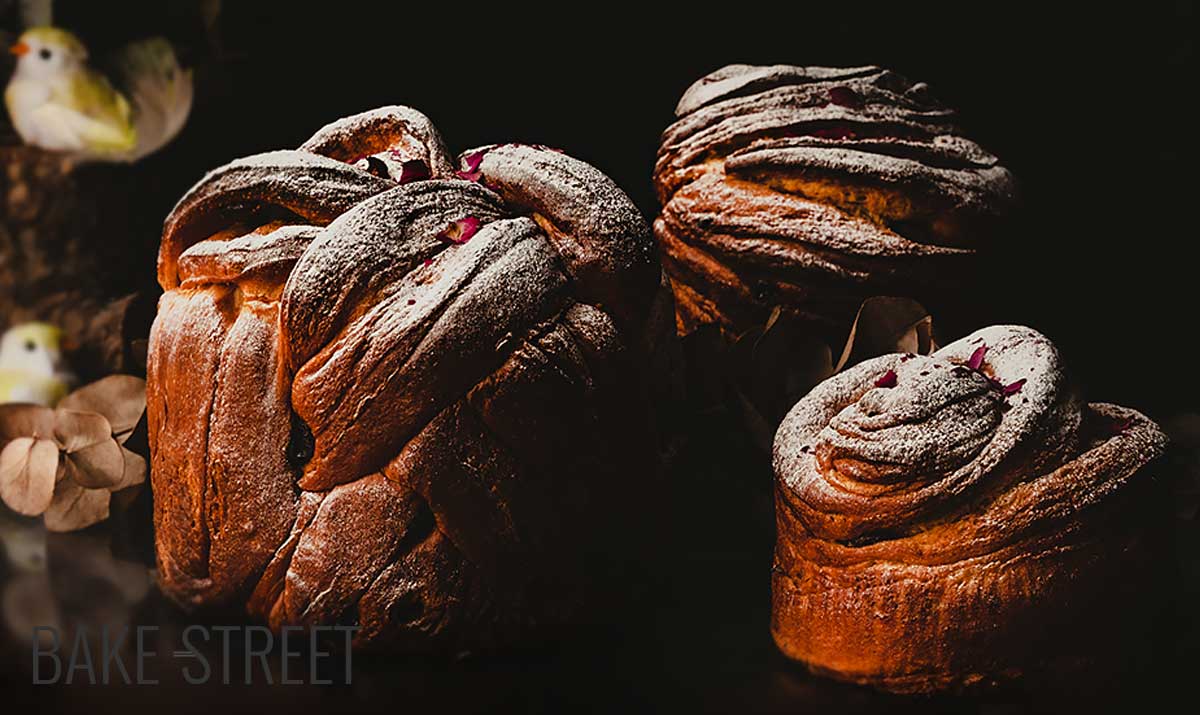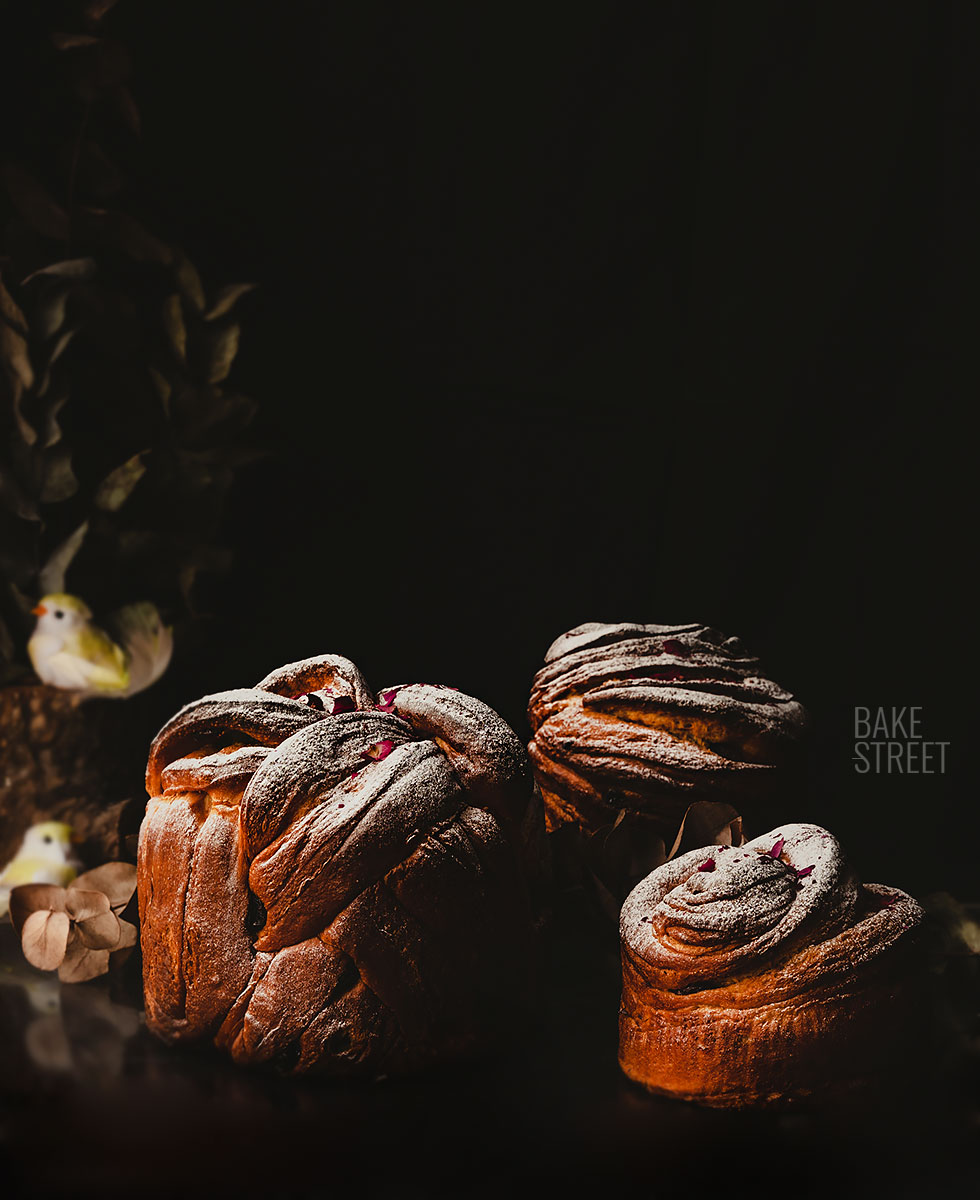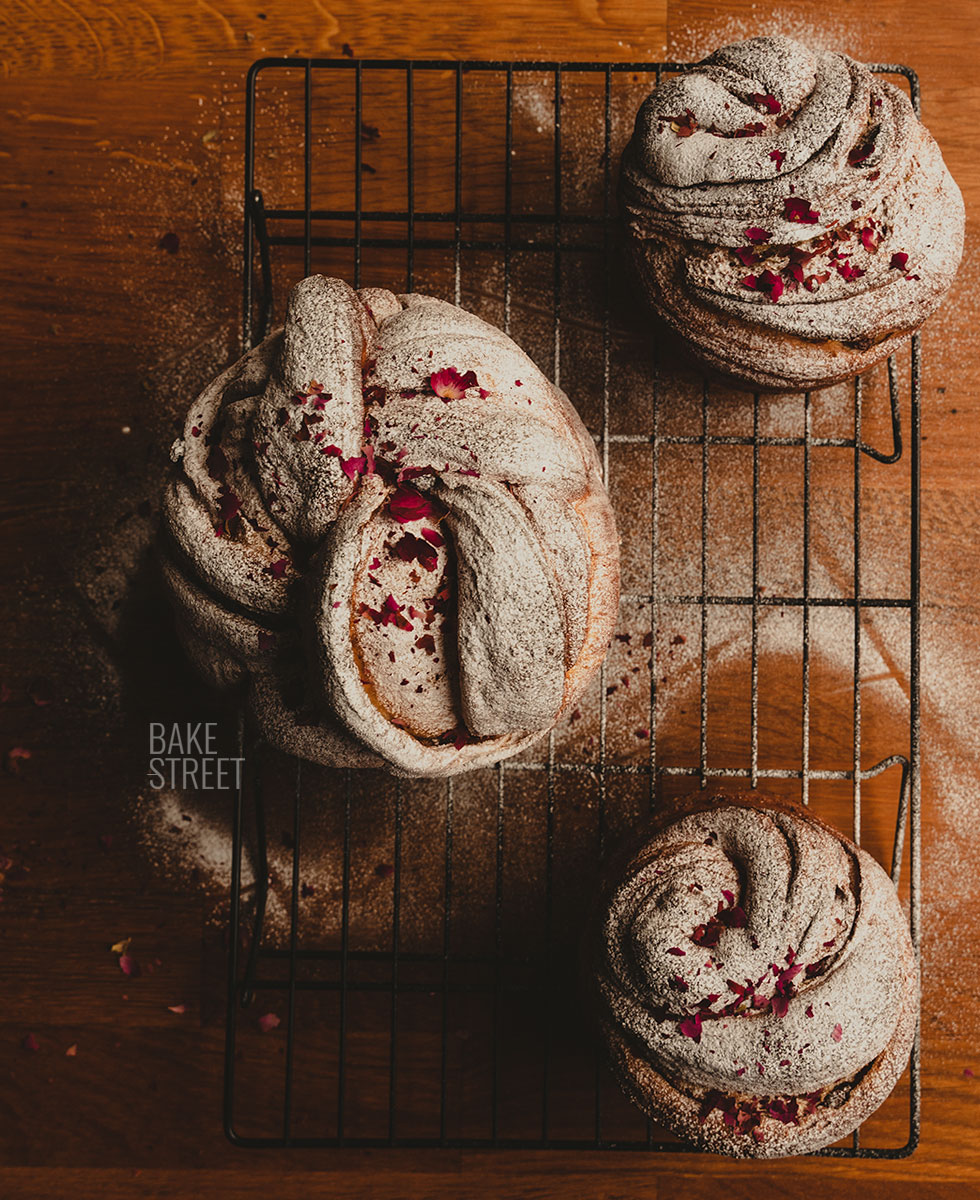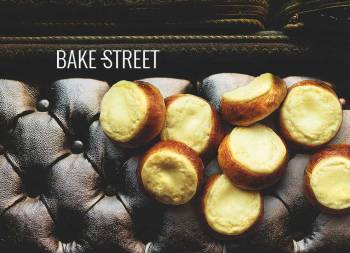
Easter Kulich Cruffin
Since last year I left you the recipe for the classic Easter Kulich, I was eager to leave you another version of this elaboration more updated or modernized. The famous Easter Kulich Cruffin that could be defined as a hybrid between Kulich and Cruffin.
Certainly, this elaboration is basically the same dough of the Kulich that I left you last year, only that the final format of presentation is very different. Instead of shaping a piece and placing into a mold to bake it, what we will do is to shape it in the same way a cruffin is shapedand then put into a mold and bake it. I am going to give you two ways to do it, the classic one that imitates the cruffin shape and, on the other hand, another option in which we will braid the dough to make a round piece.
Despite what it may seem, it is a very simple method and the result is exceptional. It can even remind us of babka or cinnamon rolls.
There are many classic and traditional preparations in which, at some point, someone decides to make a small change to modernize it and the result is a really wonderful product. In many occasions, these changes are not welcomed by everyone. But I think it is good to evolve things, always knowing where is the origin of what we do and what is the base from where what has been created is born.

When tradition evolves.
This Easter Kulich Cruffin combines the traditional Kulich dough with the cruffin forming technique. A product that in turn is a hybrid of croissant and muffin, that is, a dough that would be intended to make a croissant, but that is rolled on itself and placed in a muffin pan to bake. The result is a dough that, as I mentioned above, may remind us of babka since to achieve that “laminated” look, butter, sugar and spices (if desired) are used, as well as dried fruits.
The difference between babka and Kulich Cruffin lies in the type of dough, filling ingredients and execution of the final shaping. It seems that everything is different, but in spite of this, it still reminds us of this product. It is probably due to the fact that in order to separate layers of dough or to achieve a laminated effect, we use a filling. Although this step is found in many other elaborations such as Kringle, for example.

Undoubtedly, what is characteristic on this occasion is the method of forming it.
The Kulich Cruffin recipe appeared on the Internet in about 2019 and quickly became a real hit.
You already know that I am always fascinated to leave you the origin of the recipes I share with you. On this occasion, the elaboration is a combination of two existing recipes. So its origin is basically the combination of both thanks to the idea of some creative mind.
But, I can refer you to the origin of the Kulich, where I tell you in detail its history in this post. And I can also tell you all about the origin of the cruffin, in this other post that I left a few years ago.
I had a little mishap with the small kulich cruffin….
I wanted to adjust the baking time, so much, to achieve maximum moistness that I left them short of baking and they sank a little. I had to repeat these small pieces and, the yeast I had left at home had less leavening capacity.
The result? The dough rose, but not enough. The result was two pieces, unlike the large one, which were much shorter in height, volume and with a denser crumb. I tell you this because these things happen, more often than we would like…. And when we make the first leavening, the second one, we see that it is not going well at all. But after baking, it is confirmed. I didn’t have time to repeat them, but I thought it would be a good thing to share with you. In case in some occasion it has happened to you or happens to you, that the doughs do not go as they should, value from when the yeast has been open or if 1-2 days have passed from its date of consumption.
Recipe Easter Kulich Cruffin
DOUGH:
- 435 g Manitoba flour or high protein containe, W=380-400
- 115 g water
- 55 g sugar
- 25 g honey
- 18 g fresh yeast or 6 g dry yeast
- 3 large eggs (total 185 g)
- 165 g unsalted butter, cold
- 2 tsp vanilla extract or one vanilla pod
- 7 g salt
- 12 g milk powder, optional
- whole milk for brushing
FOR LAMINATING AND FILLING:
- 100 g unsalted butter, melted and cooled
- 35-40 g light muscovado sugar or panela
- cinnamon powder
- 50 g raisins/sultanas + 25 g cranberries
DECORATION:
- powdered sugar
- dehydrated rose petals
MATERIAL WE WILL NEED AND SHOW IN THE VIDEO:
- marble roller pin*
- scraper*
- pastry brush
- 500 g panettone mold
- 250 g panettone mold or 12 cm diameter removable metal molds
- baking steel plate, optional
*You have a 5% discount on the website Claudia&Julia using this code BAKESTREET. Delivers throughout Europe.
Instructions
FIRST DAY
Prepare dough.
- In the bowl of the stand mixer or kneader add the flour together with powdered milk (if used) and eggs.
- Mix until obtain an amalgamated dough.
- Add half of the sugar and knead again until it is completely integrated.
- Incorporate the rest of the sugar and mix.
- Pour the honey and knead until it is integrated.
- Incorporate fresh yeast, slightly crumbled, and knead again. Once we observe that it has been integrated, add the salt and continue kneading.
- Check the state of the gluten mesh, this should be quite developed. Add the vanilla and knead to help it distribute evenly.
- The gluten should be well developed, at this time we begin to add the butter. We will do it in batches and waiting for it to be fully integrated before adding more.
- Once we have added all the butter, make a rest of a few minutes and check the state of the dough. We should be able to create a thin veil by sliding it between the yolk of our hands.
Make bulk fermentation.
- Grease a bowl/tupper lightly with oil, round the dough and put it into the bowl.
- Cover with film and/or its own lid and let it rise until it grows a little more than 1/3 of its volume. In my case it took 2 hours at 70ºF/21ºC.
- At that time, keep it in the refrigerator until the next day. I left the dough 13 hours at 39,2ºF/4ºC.
SECOND DAY
Shape.
- I will show you 2 ways to shape the Kulich Cruffin, the classic way and a different one, but with very good results.
- It is very important to work the dough very cold, that is, straight out of the refrigerator. The reason is that, once the dough gains temperature, its consistency changes and it becomes difficult to stretch and manipulate.
- Remove the dough from the refrigerator and turn it out onto a lightly floured work surface.
- Degas and divide the dough into 2 equal pieces. At this point we can shape Kulich Cruffin with the whole dough and use a one kilo mold, divide into two pieces and use two half kilo molds or divide into four and use four 250 g molds. In my case I make one piece of 500 g approximately and two pieces of 250 g approximately.
- While working with one piece of dough, keep the rest inside the container and keep it refrigerated so that it does not gain temperature.
First shaping, classic.
- Shape Kulich Cruffin which will result in 2 pieces of 250 g. With the help of a rolling pin, roll out the dough to approximately 20 x 55 cm.
- Brush the entire surface with butter, sprinkle with light muscovado sugar and cinnamon.
- Place some raisins and cranberries on the surface.
- Roll the dough over itself, on the wider side.
- Refrigerate for 20 minutes, while you stretch and fill the other piece. It is important not to skip this step because the dough will have gained temperature during this process and you may find yourself with a sticky dough if you continue forming the Kulich.
- After the time in the refrigerator, divide the rolled dough piece into two parts.
- With the help of a scraper, cut the dough lengthwise to divide the rolled cylinder into two parts. It is important that you do not cut all the way through, but keep the piece together at one end.
- To form this piece, start rolling one of the ends trying to leave visible or outwards the part where you can see the laminate of the dough.
- Once you reach the joined part, place it on the spiral of dough that you have already rolled and continue rolling the piece.
- It is important to place the final end in the central part and press lightly in the center so that during rising and baking, it does not lose its shape.
- Place inside the mold, cover the surface with film and form the other piece in the same way.
Second shaping, braiding.
- Shape Kulich Cruffin which will result in 1 piece of 500 g. With the help of a rolling pin, roll out the dough to a size of approximately 25 x 35 cm.
- Brush the entire surface with butter, sprinkle with light muscovado sugar and cinnamon.
- Place some raisins and cranberries in the center of the piece.
- Fold one of the ends, in the same way as if we were closing a triptych, and place on the central part with raisins.
- Brush this fold of dough with butter, sprinkle with sugar, powdered cinnamon and place some more raisins and cranberries.
- Fold the other end over this part so that the end result is a rectangle.
- Refrigerate for 20 minutes, while you form the other pieces we filled at the beginning. It is important not to skip this step because the dough will have gained temperature during this process and we may find ourselves with a sticky dough if we continue forming the Kulich.
- After the time in the refrigerator, take out and proceed to shape.
- With the help of a scraper, cut the dough lengthwise to divide the rectangle into three equal parts. It is important that you do not cut all the way through, but hold the piece together at one end.
- Braid the dough making sure to place the side with the visible folds facing up. Once it is braided, seal the ends well.
- If you wish, you can cut the joint at the other end and braid this part. Remember to seal it well once it is braided.
- Take one of the ends and roll it over itself in the same way as if you were going to form a ball.
- Place the shaped piece inside the mold, cover with film and let rise.
Final fermentation.
- Let the shaped pieces rise until they grow a little more than double their volume, almost triple. In my case they were 2 hours and 30 minutes at 70ºF/21ºC.
Bake.
- Preheat the oven to 374ºF/190ºC with heat up and down. In my case, I also baked on a baking steel plate. If you do not have it, you can place a tray on the rack and preheat the oven with it inside.
- In my case I baked the doughs separately, first the small ones and then the big one. To prevent the dough from over-fermenting, I refrigerated the large dough while baking the small pieces.
- Brush the surface of the kulich with whole milk.
- Small pieces: Place the small molds in the oven, at medium height, and bake for 10 minutes at 374ºF/190ºC and 25 minutes at 356ºF/180ºC.
- Halfway through baking, cover the dough with aluminum foil.
- Before removing the kulich from the oven, check the internal temperature. It should be around 194º-197ºF/90º-92ºC.
Remove from the oven and let stand 5 minutes in the mold, unmold and let cool completely on a wire rack. - Large piece: Place the mold in the oven, at medium height, and bake for 10 minutes at 374ºF/190ºC and 35-40 minutes at 356ºF/180ºC. Halfway through baking, cover the dough with aluminum foil.
- Before removing the kulich from the oven, check its internal temperature. It should be around 194º-197ºF/90º-92ºC.
- Remove from the oven and let it cool completely on a wire rack.

Serve.
- We can present them as they are, but if desired, sprinkle the surface with powdered sugar and dehydrated rose petals.
- Remove the paper mold before serving the Kulich Cruffin.
- Enjoy.
Notes
- To make this dough I have used a high-strength flour, we need to use a flour with a high percentage of proteins to allow us to enrich it and carry out the fermentations which, in this case, are long.
- The sugar is added in two batches to ensure that it is well integrated into the dough and does not liquefy it. Sugar is hygroscopic, which means that it has the ability to attract moisture from the environment.
- If we do not have vanilla pods, we can use vanilla paste or vanilla extract (1 teaspoon).
- In my case I used a panettone mold and two metal molds of 12 cm in diameter. Traditionally it is usually baked in a paper mold/capsule or even baked in tins.
- It is important to respect the resting and rising times and to knead well in order to achieve a good final result. Both in flavour, aroma and texture.
- If you do not like sultanas, you can add any variety of candied fruit you like. These fruits or dried fruits help to preserve the freshness of the piece.
- In case you want to carry out a preferment to prepare the dough, you can do it as I show you in this recipe. Remember, in this case, omit the amount of water in the final dough, reduce the amount of flour to have a total of 435 g and reduce a little the final amount of yeast in the final dough.
- The number of pieces to shape is entirely up to you. In case of making a single piece with the dough, almost a kilo of dough, you will have to adjust the final baking time.
- I have shown you two ways to shape them, the classic one and another braided one that looks beautiful once baked.
- The top decoration is completely optional, you can adapt it to your personal taste.
- It keeps in perfect condition for 3-4 days in a large zip bag or tightly wrapped in film.

For those of you who like to work with enriched doughs, I am sure you will enjoy making this Easter Kulich Cruffin. The result is a very, very fluffy piece. The crumb is soft, delicate and full of incredible aromas.
A different and attractive way to carry out this piece of pastry with a slightly more sophisticated twist. Of course, you can always stick to the traditional format if you wish.
I wish you a wonderful Sunday!
Lots of love,
Eva
This post contains affiliate links.




